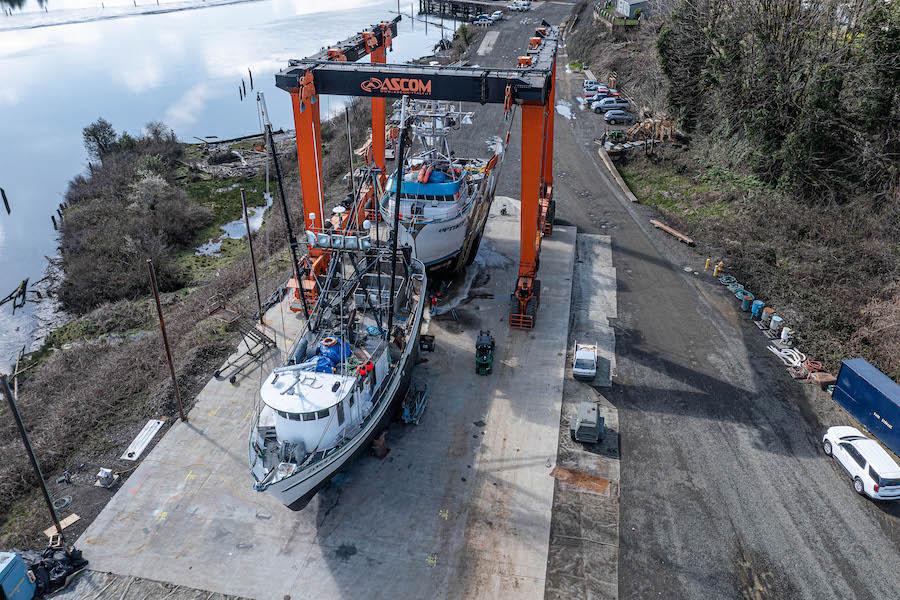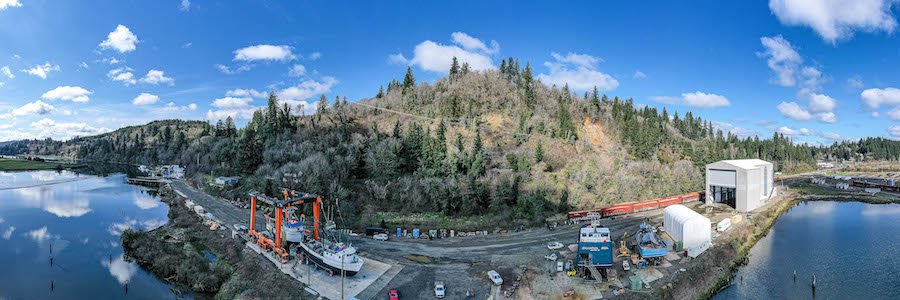Brand Story – A booming shipyard, new environmental building and industrial park expansion reflect the Port’s strategic planning.
For more than a century, the Port of Toledo has managed infrastructure near the Central Oregon Coast, starting with wharfs, jetties and roads.
Formed in 1910 to address and promote dredging for waterborne commerce, the Port successfully advocated for a full dredging of the Yaquina River in 1914. During its early history, it helped millions of tons of cargo, mainly forest products, travel down the newly cleared waterway.
In 2008, the Port took a significant first step in expanding its infrastructure. A privately-owned boatyard serving the Yaquina fleet was scheduled to be closed. Knowing that a sufficient haul-out facility was critical to retaining the local fishing fleet, a major economic contributor to the region, the Port purchased the boatyard with support from the State of Oregon.
This acquisition changed the course of the Port, which had previously relied on income from its marina and industrial properties, reflecting a new strategy centered on diversification.
 Port of Toledo’s expanding boatyard
Port of Toledo’s expanding boatyard
“In the past 15 years, during Bud Shoemake’s tenure as manager, with the leadership of the Port Commission, and especially through the support of the State of Oregon and Business Oregon, we have grown leaps and bounds with the acquisition of the shipyard. That changed everything for the Port and opened so many opportunities. It was really a turning point,” explains Lorna Davis, Port Manager, Port of Toledo. “The community, regional and state partners have been and continue to be supportive, and the Port continues to grow.”
In 2014, with a Connect Oregon V grant of $4.6 million, the Port expanded its shipyard and equipped it with a 660-ton mobile lift to accompany its 85-ton lift, enabling the Port to service Newport’s local and distant water fishing fleet — the largest working fishing fleet on the Oregon Coast.
The shipyard soon emerged as an investment with the highest potential for job creation. A one-stop-shop service provider, the Port significantly expanded its team to offer painting, steel fabrication, hull repairs, fiberglass work, mechanical repairs, deck gear installation, project management and more. These in-house teams work alongside nearly 40 skilled local businesses that directly benefit from the boatyard’s economic opportunities.
In 2016, a Connect Oregon VI grant of just over $2 million, and a Special Public Works Fund Loan from Business Oregon allowed the Port to expand the potential of its shipyard with the construction of a 20,000-square-foot environmental building, set to open its doors this spring.
“Until now, our operations have mostly been outdoors. This moves sandblasting and painting into a building, making it friendlier to the environment,” Davis says. “Oregon coast winters are brutal and that’s when we see a lot of our business because of how fisheries work. Moving our operations away from the outdoor elements helps with our business model and sets us up for the future.”
To foster the skilled labor needed to meet these growing job opportunities, the Port of Toledo partnered with the Oregon Coast Community College, the Lincoln County School District and Maritime Administration (MARAD), to launch a welding program for students. The initiative gives enrollees a doorway into a marine trade, allowing them to find quality jobs close to home. Because there were over 200 students on the waitlist, a program expansion is being considered as part of the Port’s Strategic Business Plan — specifically, its Industrial Park expansion, which will attract and grow maritime service industries.
Similarly, the Port’s high school internship program invites students interested in marine trades to spend time working in the shipyard. While growing opportunities for the region remains central to the Port of Toledo’s mission, its commitment to the community goes beyond economic development.
In recent years, the Port built a paddle park and waterfront park with gazebos and picnic areas. A paved trail, viewing platform, dock and pier let the community easily enjoy its Yaquina River. To draw visitors to Toledo and all the city offers, the Port sponsored Toledo Community Boathouse program offers boatbuilding experience, boating and water safety education, and a free family boating program throughout the summer. Additionally, the Port hosts the annual Wooden Boat Festival in August.
“It’s our responsibility to be good stewards in the community and lead by example. We want to create quality jobs. We want to grow local businesses,” Davis explains. “We want to build the Port’s financial strength to ensure successful future community programs, while being protective of our surroundings and the quality of life here.”
Uniquely, the Port of Toledo operates as both a competitive business enterprise and a public-service agency. In line with its 2018 strategy, it will continue prioritizing the Shipyard’s infrastructure, economic diversification and local training programs to support skilled marine labor.

In Toledo — where art & industry meet — a mill, art district and plethora of family-owned businesses join the Port in driving the city’s momentum: “There’s a lot of art and soul and history here, and it’s all interwoven into a community that has grown and thrived through economic challenges,” Davis says.
A challenge that most waterways face is dredging, which is vital and expensive. The U.S. Army Corps of Engineers prioritizes dredging projects based on the tonnage that comes in and out of the bay, which currently excludes fishery cargo. To ensure the Port’s long-term success, the team is working alongside other coastal ports at the federal level to include fishery harvests as cargo tonnage.
“The Port’s success will provide opportunities for the region. It is crucial to longevity. Accomplishing goals and objectives outlined in our Strategic Business Plan will ensure the Port and region will be in a strong operational position well into the future.”
Brand stories are paid content articles that allow Oregon Business advertisers to share news about their organizations and engage with readers on business and public policy issues. The stories are produced in house by the Oregon Business marketing department. For more information, contact associate publisher Courtney Kutzman.



